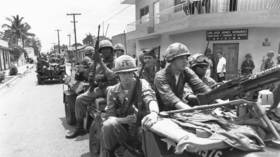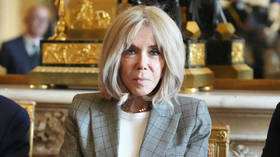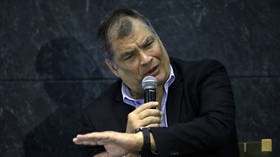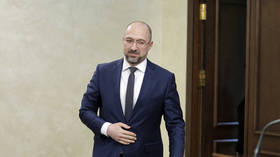Paraguay and the Trans-Pacific plot to split South America

Tiny and impoverished Paraguay has found itself in the middle of a great geopolitical game for influence over the South American continent.
Located at its core, and bordering its strongest economies, Brazil and Argentina, it is in a prime position for either aiding or hindering continental-wide integration efforts. In the past year, the latter appears to be the case, as it is now being pulled in different directions by South America’s two main trading blocs, Mercosur and the Pacific Alliance.
The country’s political pivot happened after the 2012 one-day constitutional coup that led to its suspension from Mercosur and the beginning of its flirtation with the Pacific Alliance. Paraguay’s future orientation has enormous implications, in that it can either cement Mercosur’s integrationist efforts or it can fracture the entire organization and deal a serious blow to multipolarity.
Polar opposites: Mercosur and the Pacific Alliance
Mercosur is an integrationist organization founded in 1991 after the Treaty of Asuncion. It originally comprised Brazil, Argentina, Uruguay, and Paraguay, but expanded into Venezuela in 2012 and is currently incorporating Bolivia. Its member economies are typically in favour of strong state intervention into the economy, and have voiced their support for multipolarity. Mercosur is also trying to negotiate a trade agreement with the EU.
The Pacific Alliance takes the opposite approach in most regards. It was formally created just a few years ago in 2011 and brings together Mexico, Colombia, Peru, and Chile, with Costa Rica having started the integration process earlier this year. The Pacific Alliance is fiercely neo-liberal, with John Kerry even calling it “the most open trading bloc in the hemisphere” during his visit to Panama on 1 July. Continuing to show that it is the mirror opposite of Mercosur, instead of looking towards the EU, most of the Pacific Alliance’s members are in negotiations to join the US-led Trans-Pacific Partnership (TPP).

Quite clearly, the two organizations have completely divergent economic visions and future partnerships. When looking at the foreign policies of the Mercosur members, especially that of BRICS member Brazil, it can easily be ascertained that the organization favors multipolarity in international relations. Not only that, but two of its members, Venezuela and Argentina, are highly critical of the US and the UK respectively for violating their sovereignty. The Pacific Alliance, on the other hand, actively cooperates with the US. Colombia even invited the Pentagon to access seven additional bases there in 2009 before the nation’s courts found it unconstitutional one year later.
It is thus evident that membership in either bloc entails a drastically different understanding of the world, and therefore, if a country flirts with moving from one to another, it can affect the entire continent’s political and economic arrangement.
A profile of Paraguay
Paraguay is a tiny landlocked country in the heart of South America with nearly 7 million people, the majority of whom live in the southern and eastern fringes of the country. The average person makes less than $4,000 a year and the service and agriculture sectors dominate the economy.
Energy: The country’s electricity is almost entirely dependent on the Itaipu Dam (which it shares with Brazil) and British oil company President Energy claims that one billion barrels of oil lie beneath its surface. Since the country only uses 27,000 barrels per day (much less than its neighbors), the potential for export profit is immense.
Agriculture: Brazilians own and farm large amounts of land in the East; leading to resentment among native citizens, and Monsanto is heavily active in the country. Paraguay is the world’s fourth-largest soybean exporter, with 95% of its seeds coming from Monsanto. Soybean exports were forecast to be so high in 2013 that the country was misleadingly listed by the World Bank as having one of the world’s highest GDP growth rates of 13.6%. Still, the economic growth is highly uneven and many non-corporate farmers are afraid that Monsanto will ruin their livelihoods.
Security Threats: Transnational drug and crime cartels move with ease between Brazil and Paraguay, oftentimes setting up bases along the border region. In the past, the US even suspected that the tri-state area between Paraguay, Brazil, and Argentina could be of use to terrorists. Paraguay has lately seen an upsurge in activity from the small but dangerous Paraguayan People’s Army, a hard-core leftist guerrilla organization responsible for a spate of killings and crimes in recent years. In the past six weeks, two radio hosts were also shot and killed by unknown assailants, further destabilizing the security situation.
The coup that started the pivot
Paraguay experienced a radical pivot after the one-day constitutional coup of 2012 overthrew the left-leaning Fernando Lugo and replaced him with someone right-wing and pro-business. Pepe Escobar felt that this was directed from outside by a couple of actors. He wrote that Monsanto and the Brazilian landowners had a stake in regime change, as did the US, which was getting uncomfortable with Lugo’s leftwards tilt and suspiciousness of the US military. To put matters in context, the US had previously supported coup attempts in Venezuela, Ecuador, and Bolivia. After the coup, Paraguay was suspended from both Unasur and Mercosur. It wasn’t invited back until it had presidential elections in 2013, during which Horacio Cartes, a pro-business tycoon representing the historic right-wing party, came to power. It was in this aftermath that Paraguay’s polices changed and it became the South American pivot.
From Mercosur to the Pacific Alliance
Although Paraguay was invited back into Mercosur in late-2013, it is “in no hurry with Mercosur and [is] emphasizing bilateral relations.” It previously bickered with the bloc over allowing Venezuela to join while it was suspended, although its Congress later voted to approve its entry in December 2013. Also, the period of suspension allowed its elite to envision other alternatives besides Mercosur, namely, the Pacific Alliance. The Pacific Alliance has actually come to be viewed as a challenger and potential threat to Mercosur’s integrationist efforts, especially since it seems as though they are now courting Paraguay. In September 2013, Chile offered Paraguay access to its Pacific port of Antofagasta, and the Paraguayan Foreign Minister returned at the end of June from the Pacific Alliance’s summit in Mexico.
Paraguay’s plan
Asuncion set an important condition for its full return to Mercosur: it wants members to be able to negotiate bilateral trade agreements outside the organization’s framework.
This is something forbidden within Mercosur, since the group’s idea is to work as a unified whole and a single economic space. Bolivia is in both the Andean Community (Pacific Alliance members Peru and Colombia freely trade with one another here) and Mercosur, but it reached a special agreement to have this happen.
Paraguay is acting unilaterally and this raises concerns of ulterior motives by Mercosur’s one-time joint-founder. Independent bilateral trade agreements would wreck the entire venture, but Paraguay is now on the verge of signing an agreement with Chile for a free trade zone in Antofagasta, a move that will almost surely result in it being sanctioned by Mercosur. This in turn could provide the manufactured window of opportunity for the Pacific Alliance to reach out to Paraguay and poach it from Mercosur.
After all, such rapid and radical policy shifts have been done before, most recently in Ukraine during its first 100 days after the 21 February coup. This proves that such a pattern is definitely repeatable if the circumstances can be properly engineered.
What a ‘Pacific Paraguay’ would look like
If Paraguay entered the Pacific Alliance, it would have a backdoor to the TPP through its free trade agreement with Chile. It could use this to sell its soybeans further afield in East Asia, raising the profits of Monsanto, the large Brazilian landowners, and the political business elite. It may even make it easier for President Energy to import the necessary oil-extracting devices and related equipment into the country, among other things. Paraguay in the Pacific Alliance would also place Mercosur in a conundrum, since the country would literally be an economic island surrounded by the organization, but one must remember the setup that Bolivia got itself into, likely unwittingly. By being in both the Andean Community and Mercosur, it has free trade with Peru, which is negotiating with the TPP. This is the backdoor for TPP and Pacific Alliance goods to transit through Bolivia to Paraguay, creating a lifeline with its future partner.
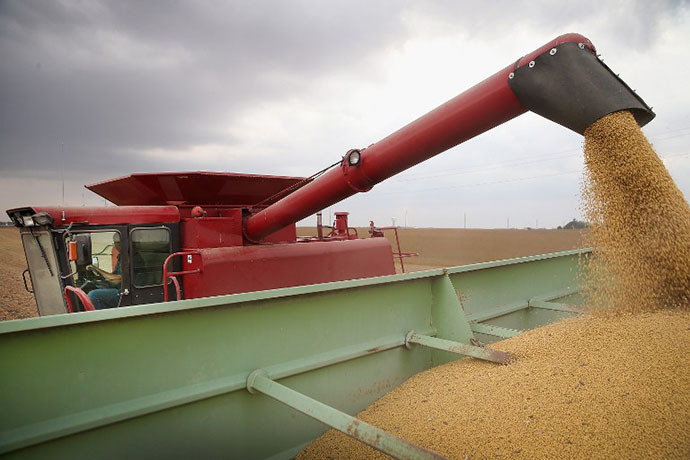
The defection of Paraguay and the economic confusion this creates for the Mercosur members could destabilize the organization and halt its integration activity. This would by comparison increase the influence of the Pacific Alliance, which is essentially a US economic proxy organization. This would by extension divide the continent, contain Brazil (which has the most to gain from Mercosur), and expand American influence into the center of South America. Following the Colombian military example, it is not too far of a step to envision Paraguay requesting American military support for fighting against the ‘FARC-lite’, the Paraguayan People’s Army. This could result in a chain reaction of coups in South America. What started in Paraguay could spread to Bolivia, Ecuador, and finally possibly succeed in Venezuela. With Bolivia acting as the ‘highway’ between Peru and Paraguay and Ecuador caught in between both Peru and Colombia, it would be easier to infiltrate and then divide-and-rule these resistant governments on the path to the main prizes, Venezuela and Brazil.
South America as caught between the Pacific and Atlantic
Regardless of what happens with Paraguay, one thing is certain – the South American continent is being divided between West and East, Pacific and Atlantic. The Pacific Alliance conveniently goes along with the Washington economic consensus and has strong military ties to it, while Mercosur, its Atlantic counterpart, favors multipolarity. After each trading bloc consolidates around its core (Western South America for the Pacific Alliance and Brazil for Mercosur), it is inevitable that they will soon expand and meet one another in the central part of the continent, in Paraguay and Bolivia. If the Pacific Alliance is successful in poaching either of these two members, Brazil can quickly find itself isolated in South American affairs and suddenly contained. With America on the move in Eastern Europe, the Mideast, Africa, and Southeast Asia, it is only a matter of time before they initiate a Paraguayan power play in South America.
Andrew Korybko for RT
The statements, views and opinions expressed in this column are solely those of the author and do not necessarily represent those of RT.
The statements, views and opinions expressed in this column are solely those of the author and do not necessarily represent those of RT.


